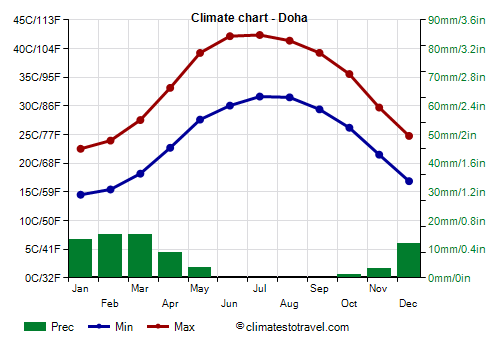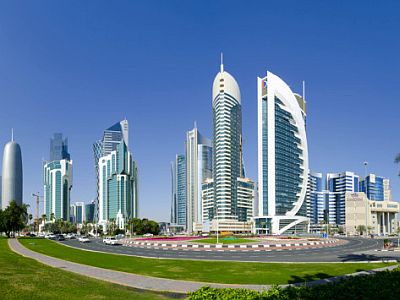Select units of measurement for the temperature and rainfall tables (metric or imperial).
Average weather, temperature, rainfall, sunshine
In Qatar, a country that occupies a small flat peninsula in the Persian Gulf, there is a
desert climate, with very mild winters, and very hot and sunny summers.
The scarce
rains occur almost all in winter and spring, from December to April.
The rains in Qatar occur in the form of brief (but sometimes heavy) showers, which can sometimes fill the
wadis, the river beds which remain dry most of the year, and even cause flooding.
The prevailing
wind is moist and blows from the north-west, more frequently in the summer months.
Another wind, hot and dry, can blow throughout the year, but preferably in spring. It blows from the south and it's able to raise the temperature to about 30 °C (86 °F) in winter and to about 40 °C (104 °F) and above from April to October, while drastically lowering relative humidity. It is also able to raise dust and sand storms.
The climate in detail
The seasons
Basically, there are two main seasons: a cooler season from December to February, and a hot season from April to October, within which we can distinguish a very hot period from May to mid-October. March and November are transitional months, warm but without excesses.
In
winter, from December to February, temperatures are mild and the sky is often clear, so, it's a spring-like season. Lows are around 14/17 °C (57/63 °F) and highs around 22/25 °C (72/77 °F).
However, there can be some cool and windy days, especially in January, with temperatures below 10 °C (50 °F) and night and around 15/16 °C (59/61 °F) at mid-day. The coldest record is 5 °C (41 °F) and was set in January 1992.
Summer is very hot: from June to August, highs are around 42/43 °C (108/109 °F) and lows around 30/32 °C (86/89 °F).
There are torrid days (that is, very hot and dry), when the wind blows from the Arabian desert, and the daytime temperatures rise above 40 °C (104 °F), while other periods are less hot but more humid, with highs around 37/38 °C (99/100 °F) and sweltering heat. The highest record is 50.4 °C (122.7 °F) and was set in July 2010.
Over the course of the summer, relative
humidity gradually increases, so much so that the second part of the season, in August and September, is particularly stifling. The combination of moisture and temperature that is recorded in summer in the Persian Gulf countries is actually one of the worst in the world.
Doha

In
Doha, the capital, the daily average temperature ranges from 18.5 degrees Celsius (65 °F) in January to 37 °C (99 °F) in July.
The
rainfall amounts to only 75 millimeters (3 inches) per year. In summer it never rains.
In Qatar, the
sun shines regularly, in fact there are more than 3,400 hours of sunshine per year. Sometimes, however, some cloud banks can reach the country, even in summer.

Sea temperature
The
sea in Qatar is a bit cool from January to March, particularly in February, when it reaches the lowest temperature, about 20 °C (68 °F), while it's still quite warm in December, when it's about 24 °C (75 °F). In summer, the waters of the Persian Gulf become very warm, exceeding 30 °C (86 °F) from June to October.
When to go
The best time to visit Qatar runs from
mid-November to mid-March: it is the only time of the year that is not hot.
In general, the weather is mild and sunny from December to February, and warm but not too much in November and March. Some cloudy days are possible, sometimes with rain, especially from December to February.
What to pack
In
winter: bring light clothes for the day, a sweater and a jacket for the evening and for cool days, and a scarf for the wind.
In
summer: bring lightweight clothes, made of natural fabric (cotton or linen), a desert turban, and a sweatshirt and a scarf for air conditioned places. It's better for women to avoid shorts and miniskirts outside of tourist resorts.
When going to the reef, you can bring snorkeling equipment, including water shoes or rubber-soled shoes.
Climate data - Qatar
| Doha |
|---|
|
| Jan | Feb | Mar | Apr | May | Jun | Jul | Aug | Sep | Oct | Nov | Dec |
|---|
| Min temp. | 15 | 15 | 18 | 23 | 28 | 30 | 32 | 31 | 29 | 26 | 22 | 17 |
|---|
| Max temp. | 23 | 24 | 28 | 33 | 39 | 42 | 42 | 41 | 39 | 36 | 30 | 25 |
|---|
| Precip. | 15 | 15 | 15 | 10 | 5 | 0 | 0 | 0 | 0 | 0 | 5 | 10 |
|---|
| Prec. days | 2 | 2 | 2 | 1 | 0 | 0 | 0 | 0 | 0 | 0 | 0 | 1 |
|---|
| Humidity | 66% | 63% | 55% | 45% | 36% | 35% | 42% | 54% | 56% | 58% | 61% | 67% |
|---|
| Day length | 11 | 11 | 12 | 13 | 13 | 14 | 14 | 13 | 12 | 12 | 11 | 11 |
|---|
| Sun hours | 8 | 8 | 8 | 9 | 10 | 11 | 10 | 11 | 10 | 10 | 9 | 8 |
|---|
| Sea temp | 21 | 20 | 21 | 24 | 28 | 30 | 32 | 34 | 33 | 31 | 28 | 24 |
|---|